| . |  |
. |
At the U.S. Department of Energy's Brookhaven National Laboratory, scientists have developed a new chemical "writing" technique that can create lines of "ink" only a few tens of nanometers, or billionths of a meter, in width. "Our new 'writing' method opens up many new possibilities for creating nanoscale patterns and features on surfaces. This may have a significant impact on developing nanotechnologies that involve nanopatterning, such as molecular electronics - tiny circuits built using single organic molecules," said Brookhaven Lab physicist Yuguang Cai. Cai will discuss the method at the 230th American Chemical Society national meeting in Washington, D.C., on Sunday, August 28, at 12 p.m. in room 8-9 of the Renaissance Hotel. Cai and his colleagues call the technique "Electro Pen Nanolithography" (EPN). They sweep a very thin metal tip across a film of organic molecules. The tip carries an electric voltage, which causes the region under it to "oxidize," or undergo a reaction that changes the chemical makeup of the film. In a single sweep of the pen, organic "ink" molecules are transferred from the tip to the oxidized regions, creating an extremely thin line. Each line is just one molecule thick, but the researchers can produce multilayered patterns by writing over the existing pattern. This gives them the ability to create three-dimensional nanoscale "landscapes." Moreover, by turning off the voltage, they can use the tip as a tiny "scanner" to "read" and create an image of the pattern just written. With further research, EPN may have the ability to "write" biomolecular materials, such as proteins, onto surfaces. These nanoscale protein deposits might, for example, serve as biosensors. Related Links TerraDaily Search TerraDaily Subscribe To TerraDaily Express  Tucson AZ (SPX) Aug 26, 2005
Tucson AZ (SPX) Aug 26, 2005University of Arizona physicists have discovered what it takes to make metal 'nanowires' that last a long time. This is particularly important to the electronics industry, which hopes to use tiny wires in Lilputian electronic devices in the next 10 to 15 years.
|
| ||||||||||
| The content herein, unless otherwise known to be public domain, are Copyright 1995-2016 - Space Media Network. All websites are published in Australia and are solely subject to Australian law and governed by Fair Use principals for news reporting and research purposes. AFP, UPI and IANS news wire stories are copyright Agence France-Presse, United Press International and Indo-Asia News Service. ESA news reports are copyright European Space Agency. All NASA sourced material is public domain. Additional copyrights may apply in whole or part to other bona fide parties. Advertising does not imply endorsement, agreement or approval of any opinions, statements or information provided by Space Media Network on any Web page published or hosted by Space Media Network. Privacy Statement All images and articles appearing on Space Media Network have been edited or digitally altered in some way. Any requests to remove copyright material will be acted upon in a timely and appropriate manner. Any attempt to extort money from Space Media Network will be ignored and reported to Australian Law Enforcement Agencies as a potential case of financial fraud involving the use of a telephonic carriage device or postal service. |